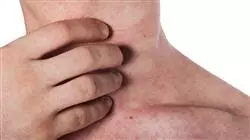University certificate
The world's largest faculty of medicine”
Introduction to the Program
Get up to date on the main allergens and diagnostic techniques, including Prick test, Prick by Prick and epicutaneous tests"

Various factors such as pollution, changes in eating habits, overweight or a more sedentary lifestyle have contributed significantly to the progressive increase in the number of people suffering from some type of allergy. This trend is worrying, especially in the elderly and children, where certain food or pharmacological allergies can be more sensitive.
In fact, the most common allergies are respiratory, food and contact allergies, with particular emphasis on reactions to egg and milk protein, mites, pollens, metals and some types of topical medications. This situation has boosted innovation and research in the field, with outstanding advances in areas such as immunotherapy or diagnostic devices. Specialists are therefore called upon to an almost continuous updating process in view of the growth of both the number of cases to be treated and the methodologies used to treat them.
It is at this juncture that TECH's Advanced master’s degree in Allergology is justified, as it compiles the most relevant scientific postulates and developments in both common allergies in adulthood and those treatments and approaches more specific to the pediatric area. The specialist will have access to a myriad of multimedia resources, complementary readings, analysis of real cases and more material with which to be updated in a reliable way in epidemiology, approaches, diagnosis and the most modern allergological research.
The entire syllabus has been developed by a team of experts with extensive experience in the care of allergic patients, working in major clinical centers and hospitals. This is essential to provide the entire syllabus with the necessary practical vision, giving the specialists not only the most innovative work methodology but also the way to apply it and carry it out in the real clinical field.
A completely online and flexible program, without the usual ties of face-to-face classes or fixed schedules. It is the specialists who decide how to distribute the entire teaching load, being able to adapt it to their own work and personal responsibilities. To this end, the entire syllabus is available on the Virtual Campus for downloading from any device with an Internet connection.
It delves into the most prevalent fields of Allergology today, highlighting food, respiratory and pharmacological allergens"
This Advanced master’s degree in Allergology contains the most complete and up-to-date scientific program on the market. The most important features include:
- The development of case studies presented by experts in allergies
- The graphic, schematic, and practical contents with which they are created, provide scientific and practical information on the disciplines that are essential for professional practice
- Practical exercises where self-assessment can be used to improve learning
- Its special emphasis on innovative methodologies in allergy diagnosis and management
- Theoretical lessons, questions to the expert, debate forums on controversial topics, and individual reflection assignments
- Content that is accessible from any fixed or portable device with an Internet connection
You will have a Virtual Campus available 24 hours a day, being able to choose when, where and how to take on the entire teaching load"
It includes in its teaching staff professionals belonging to the field of pediatrics, who pour into this program the experience of their work, in addition to recognized specialists of reference societies and prestigious universities.
The multimedia content, developed with the latest educational technology, will provide the professional with situated and contextual learning, i.e., a simulated environment that will provide an immersive learning experience designed to prepare for real-life situations.
This program is designed around Problem-Based Learning, whereby the student must try to solve the different professional practice situations that arise throughout the program. For this purpose, the professional will be assisted by an innovative interactive video system created by renowned and experienced experts.
Delve into the future of Allergology at the research level in this TECH Advanced master’s degree”

Benefit from high quality multimedia material, rich in details on the most relevant allergic cases in the clinical setting”
Why study at TECH?
TECH is the world’s largest online university. With an impressive catalog of more than 14,000 university programs available in 11 languages, it is positioned as a leader in employability, with a 99% job placement rate. In addition, it relies on an enormous faculty of more than 6,000 professors of the highest international renown.

Study at the world's largest online university and guarantee your professional success. The future starts at TECH”
The world’s best online university according to FORBES
The prestigious Forbes magazine, specialized in business and finance, has highlighted TECH as “the world's best online university” This is what they have recently stated in an article in their digital edition in which they echo the success story of this institution, “thanks to the academic offer it provides, the selection of its teaching staff, and an innovative learning method aimed at educating the professionals of the future”
A revolutionary study method, a cutting-edge faculty and a practical focus: the key to TECH's success.
The most complete study plans on the university scene
TECH offers the most complete study plans on the university scene, with syllabuses that cover fundamental concepts and, at the same time, the main scientific advances in their specific scientific areas. In addition, these programs are continuously being updated to guarantee students the academic vanguard and the most in-demand professional skills. In this way, the university's qualifications provide its graduates with a significant advantage to propel their careers to success.
TECH offers the most comprehensive and intensive study plans on the current university scene.
A world-class teaching staff
TECH's teaching staff is made up of more than 6,000 professors with the highest international recognition. Professors, researchers and top executives of multinational companies, including Isaiah Covington, performance coach of the Boston Celtics; Magda Romanska, principal investigator at Harvard MetaLAB; Ignacio Wistumba, chairman of the department of translational molecular pathology at MD Anderson Cancer Center; and D.W. Pine, creative director of TIME magazine, among others.
Internationally renowned experts, specialized in different branches of Health, Technology, Communication and Business, form part of the TECH faculty.
A unique learning method
TECH is the first university to use Relearning in all its programs. It is the best online learning methodology, accredited with international teaching quality certifications, provided by prestigious educational agencies. In addition, this disruptive educational model is complemented with the “Case Method”, thereby setting up a unique online teaching strategy. Innovative teaching resources are also implemented, including detailed videos, infographics and interactive summaries.
TECH combines Relearning and the Case Method in all its university programs to guarantee excellent theoretical and practical learning, studying whenever and wherever you want.
The world's largest online university
TECH is the world’s largest online university. We are the largest educational institution, with the best and widest online educational catalog, one hundred percent online and covering the vast majority of areas of knowledge. We offer a large selection of our own degrees and accredited online undergraduate and postgraduate degrees. In total, more than 14,000 university degrees, in eleven different languages, make us the largest educational largest in the world.
TECH has the world's most extensive catalog of academic and official programs, available in more than 11 languages.
Google Premier Partner
The American technology giant has awarded TECH the Google Google Premier Partner badge. This award, which is only available to 3% of the world's companies, highlights the efficient, flexible and tailored experience that this university provides to students. The recognition as a Google Premier Partner not only accredits the maximum rigor, performance and investment in TECH's digital infrastructures, but also places this university as one of the world's leading technology companies.
Google has positioned TECH in the top 3% of the world's most important technology companies by awarding it its Google Premier Partner badge.
The official online university of the NBA
TECH is the official online university of the NBA. Thanks to our agreement with the biggest league in basketball, we offer our students exclusive university programs, as well as a wide variety of educational resources focused on the business of the league and other areas of the sports industry. Each program is made up of a uniquely designed syllabus and features exceptional guest hosts: professionals with a distinguished sports background who will offer their expertise on the most relevant topics.
TECH has been selected by the NBA, the world's top basketball league, as its official online university.
The top-rated university by its students
Students have positioned TECH as the world's top-rated university on the main review websites, with a highest rating of 4.9 out of 5, obtained from more than 1,000 reviews. These results consolidate TECH as the benchmark university institution at an international level, reflecting the excellence and positive impact of its educational model.” reflecting the excellence and positive impact of its educational model.”
TECH is the world’s top-rated university by its students.
Leaders in employability
TECH has managed to become the leading university in employability. 99% of its students obtain jobs in the academic field they have studied, within one year of completing any of the university's programs. A similar number achieve immediate career enhancement. All this thanks to a study methodology that bases its effectiveness on the acquisition of practical skills, which are absolutely necessary for professional development.
99% of TECH graduates find a job within a year of completing their studies.
Professional Master's Degree in Pediatric Allergology
Allergology is a branch of medicine that deals with the study, diagnosis and treatment of allergic diseases. Allergies are abnormal immune responses of the body to substances that are normally harmless, including pollen, dust, food or drugs. Would you like to specialize in this field? The Professional Master's Degree in Pediatric Allergology created by TECH Global University will help you to fulfill this purpose. The program, taught 100% online, offers you a comprehensive and up-to-date approach to the most common allergic diseases such as allergic rhinitis, asthma, atopic dermatitis and food allergies. In addition, you will learn the fundamentals of immunology and the pathophysiology of allergies, as well as the most advanced diagnostic techniques and the most effective therapeutic options. All this, without having to leave home, with the best teaching tutorials and interactive material that will give that rewarding plus to your professional profile.
Be an expert in allergology
The Professional Master's Degree is designed for health professionals who wish to expand their knowledge and specialize in a highly innovative area. This completely virtual program will add to your curriculum the most updated competencies in the market so that you can perform effectively in the field of allergology. Our team of experts will guide you through the program, providing you with quality training based on the latest scientific evidence. In addition, the program includes case studies and exercises that will allow you to apply the knowledge acquired in real situations, which will help you to strengthen and consolidate your academic preparation. Upon completion of the program, you will obtain an internationally recognized degree endorsed by our institution. This degree will open doors to new professional opportunities and position you as an expert in the field of allergology.







